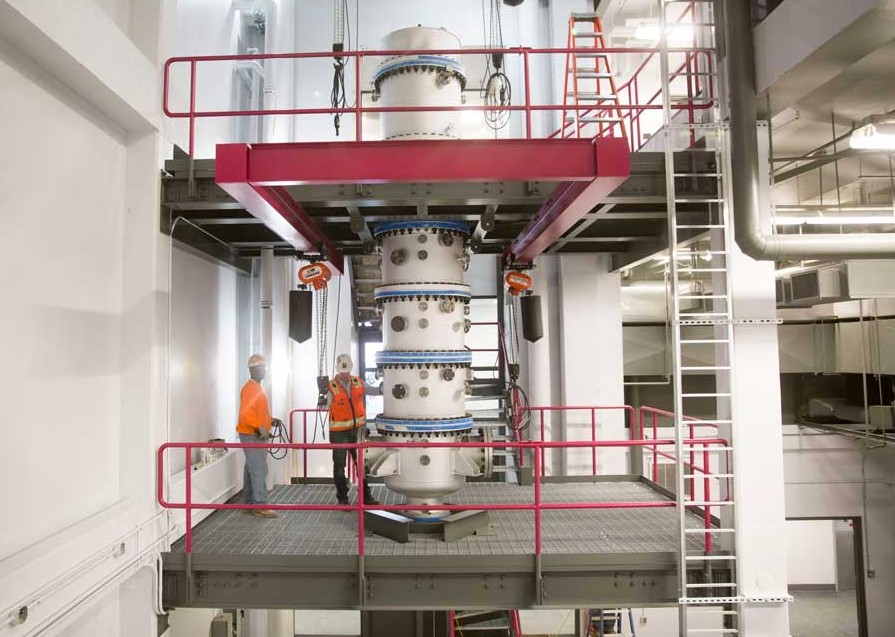Future or Farce: A Look at Washington University's Consortium for Clean Coal Utilization

By Nina Giraldo
January 24, 2022 - Washington University’s Consortium for Clean Coal Utilization (CCCU) describes itself as a research center on the cutting edge of climate solutions. However, the consortium’s support for the continued use of fossil fuels and its focus on carbon capture and sequestration have faced scrutiny as scientists and activists sound alarms about the urgency of addressing climate change.
Consortium leaders suggest that limiting emissions from coal power production is a key tool in the fight against climate change, while critics argue that carbon capture and other technologies distract from the need for a quicker transition away from fossil fuels.

Workers place the finishing touches on the space for Urbauer Hall’s lab-sized pressurized oxy-combustor in 2015.
Photo by Megan Magray / Student Life
Established in 2008, the CCCU focuses its research on carbon capture and sequestration, advocating for the use of fossil fuels alongside solar and wind power. The consortium receives funding from coal companies Ameren, Peabody and Arch Coal in addition to the federal government, but Director of the CCCU and Professor in Energy, Environmental and Chemical Engineering Richard Axelbaum says the University retains research decision-making power.
Recently the CCCU developed pressurized oxy-combustion technology that Axelbaum said is “one of the top contenders in the world” for carbon capture technology and effectively dealing with the unreliability of renewable sources. The research resulted in a $6 million project with the U.S. Department of Energy, Axelbaum said.
However, anthropology professor Bret Gustafson referred to the CCCU as “a bit like a farce,” arguing that “corrupt coal industries” want to keep burning fossil fuels to maintain a militaristic economy and satisfy corporate interests.
“It’s simply their way of using the University to improve the image of coal,” Gustafson said. “That’s a problem when the University starts participating in corporate propaganda.”
Vice Chancellor for Marketing and Communications Julie Flory declined to comment on critiques of the consortium and Gustafson’s comments about the University.
Axelbaum acknowledged fossil fuel companies’ self-interest in funding the consortium’s research but said their agendas do not affect the consortium’s decision-making. He added that the consortium’s eventual goal is to develop technologies that can attract more funding from the federal government instead.
“The decision-making is dictated by the University, but the funding comes from the companies, and for obvious reasons, they would like to see technologies develop that have a path forward for coal,” Axelbaum said. “What we’re doing with these funds [from fossil fuel companies] is leveraging them to be able to get government funding. So the real goal is not to utilize consortium funds, but to seed the opportunities so you can develop approaches to things that will lead to federal funding.”
Beyond the emission of carbon dioxide, Gustafson said that coal’s status as a toxic pollutant in every stage of its extraction, transportation and conversion to energy necessitates the end of its use. He described the phrase “clean coal” as a branding strategy of the coal industry to improve its public image and compared the expression to the “clean tobacco” propaganda of the tobacco industry.
“From the very moment that workers remove coal from the earth, it is dirty and it is toxic,” Gustafson said. “The use of the phrase ‘clean coal’ distorts the public understanding and distorts students’ understandings of what the research actually is.”
Axelbaum pushed back against critiques of the consortium, arguing that fossil fuels are necessary in order to continue raising the standard of living for a growing population.
“Fossil fuels have brought us life,” Axelbaum said. “It’s made us live longer and has brought our standard of living to where we’re living like kings and queens.”
Environmental groups have long raised concerns about the messaging surrounding carbon capture technology, especially as President Donald Trump often focused on the idea of “clean coal” during his administration. Critics cite that producing electricity through natural gas, solar, wind or nuclear plants is still far cleaner than coal plants that emit less carbon dioxide.
Axelbaum critiqued the idea of a transition to 100% renewable energy, arguing that continued fossil fuel use is necessary to stabilize energy supply given seasonal and daily variations of wind and solar power and that the closure of coal plants would eliminate the stability that fossil fuels provide.
Wind and solar sources of energy are both highly weather-dependent, leading some experts to deem them unreliable. California’s August 2020 blackouts were in part driven by the state’s reliance on wind and solar energy sources, highlighting the challenges of an unstable energy supply.
“In an effort to argue we don’t want fossil fuels, that one thing… that could help wind and solar be successful is being villainized and removed,” Axelbaum said.
While wind and solar are more susceptible to variation than fossil fuels, some natural gas powered-plants have also experienced weather-related shutdowns in recent years.
Israel Institute Teaching Fellow in Israeli and Environmental Studies Elai Rettig said that the advantages of coal make it a difficult resource to overlook. He described the CCCU’s work as a pragmatic way to use fossil fuels in a cleaner, more efficient manner.
“That’s where the carbon capture comes into place because we need to accept one truth, and it’s a truth that’s hard to settle: coal is fantastic,” Rettig said. “It’s very safe. It’s very concentrated, and it’s very, very abundant.”
Still, Rettig said that, as the effects of carbon dioxide emissions outweigh the benefits of fossil fuels, coal consumption must be reduced. He said that fossil fuels should continue to act as a “support system” for renewable energy until storage capacity batteries become sufficient.
“Even in the most ideal net zero emission scenario, we’re still using fossil fuels,” Rettig said, “but we’re doing it much more efficiently.”
Suzanne Loui, lecturer in environmental studies, further emphasized the importance of “keeping everything on the table” in order to find solutions that meet a variety of human needs.
“I don’t think we should stop looking at any of our energy technologies, I think we should get better at all of them,” Loui said. “Then we can gradually start improving our use of renewables and other non-carbon-emitting sources. But until we can do that, I think we have to keep exploring ways to improve what we already know how to do with even fossil fuels.”
However, Gustafson remained committed to achieving total renewable energy. He cited the Solutions Project at Stanford University as a roadmap to 100% renewable energy, arguing that there should be greater focus on implementing battery storage at scale rather than developing carbon capture technologies, which he emphasized have possible deadly effects.
Gustafson opposed plans where companies profit from the collection of carbon dioxide by selling it to oil and gas industries, which would in turn be used to force more oil and gas out from wells.
“The cheapest way to achieve energy security and reliability is with clean, renewable, local energy,” he said. “Anything they do to try to delay that? I see that as criminal. The planet doesn’t have time.”

